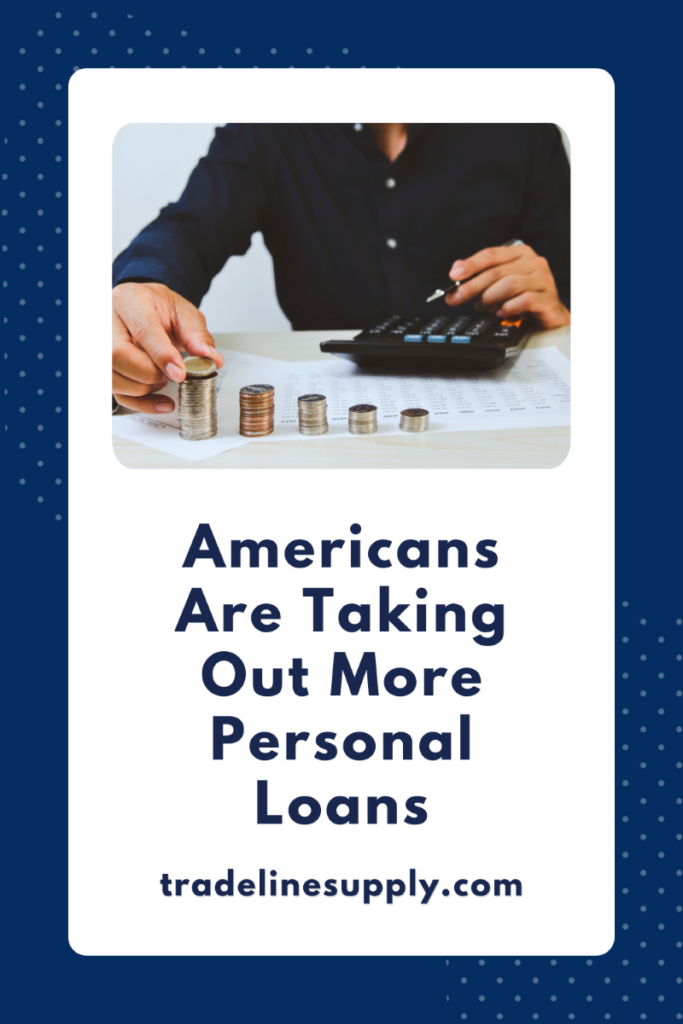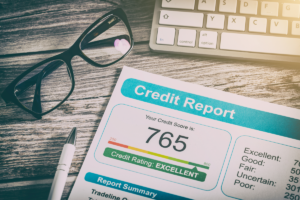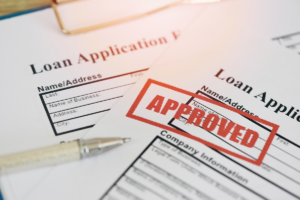Americans Are Taking Out More Personal Loans: What You Need to Know

Credit Mix: Do You Need to Care About Types of Credit? [Infographic]
06/06/2024
Date of Last Activity (DLA): What Is It and Does It Really Matter?
06/27/2024 Personal loans have grown in popularity over the years. As more Americans take out personal loans, many households are adding another monthly payment to their budgets. While an unsecured personal loan offers a flexible way to cover any number of expenses, taking on another loan can lead to more financial strain.
Personal loans have grown in popularity over the years. As more Americans take out personal loans, many households are adding another monthly payment to their budgets. While an unsecured personal loan offers a flexible way to cover any number of expenses, taking on another loan can lead to more financial strain.
We will explore statistics about U.S. personal loans, why Americans might be turning to these loans, and the process of getting a personal loan. Additionally, we will share ways you can work with your finances to avoid taking out a personal loan.
Americans Are Taking Out More Personal Loans
According to a recent TransUnion report, personal loan balances reached $245 billion in the first quarter of 2023. That’s up from a total balance of $144 billion in the first quarter of 2021.
In addition to a rising total balance for all Americans, the average amount of personal loan debt per borrower has grown. In the first quarter of 2024, the average personal loan borrower held $11,829 in debt. Back in the first quarter of 2021, the average personal loan balance per borrower was only $8,817.
The number of borrowers with unsecured personal loans reached 23.5 million in 2023, compared to 19 million in 2021. The steep rise in these figures highlights the growing popularity of personal loans in America.
Why Are Americans Taking Out More Personal Loans?
The numbers make it clear that Americans are taking out more personal loans. But what the numbers don’t show is why households are leaning on this type of unsecured debt.
Below are some of the reasons why more Americans might be taking out personal loans.
Inflation
Inflation has been a persistent problem since mid-2021, according to data from the Federal Reserve. As prices have risen, households have felt the pinch. With rising costs for the essentials, it’s not surprising that Americans are dealing with tighter budgets.

When it’s difficult to make ends meet, it’s tempting to turn to a loan product. For some Americans, the option to take out a personal loan is a welcome reprieve from their financial stress.
Interest Rates
In an effort to combat inflation, the Federal Reserve has been raising interest rates, and higher interest rates have made taking out credit of any kind more expensive.
For example, credit card interest rates rose from an average of 14.60% in 2021 to 24.80% in June 2024. But notably, personal loans often have lower interest rates attached than credit cards. According to Bankrate, as of June 2024, the average personal loan interest rate is 12.35%.
If households have to choose between putting an expense on their credit card or taking out a personal loan, the lower interest rates attached to most personal loans are undeniably attractive. As interest rates continue to rise, more consumers might turn to personal loans as an alternative to credit cards.
Consumption
With the world reopening, many Americans took the chance to splurge. Although not every household can afford to splurge, many can. As Americans look to increase or maintain their consumption, inflation can make those purchases add up faster.
How to Get a Personal Loan
A personal loan can present an attractive option for many households. Unlike a credit card with changing interest rates and unpredictable payments, you’ll know exactly what you are signing up for when you take out a personal loan.
Here’s how you can get a personal loan.
Check Your Credit
Like other types of loans, borrowers with higher credit scores tend to unlock the most attractive personal loan offers. With that, it’s a good idea to determine where your credit stands before diving into the process of getting a personal loan.
Once you check your credit, you can decide the best course of action. If your credit score is good, then you might not need to make any improvements. But if your credit score isn’t good, then you might want to spend some time improving your credit score before you move forward with your personal loan plans.
In general, borrowers with a credit score of at least 670 will unlock reasonably good rates. While it’s possible to get a personal loan with a lower credit score, you might miss out on the opportunity to get the best interest rates.
If you decide to work on your credit score, some useful strategies include paying all of your bills on time, reducing your credit card balances, and removing inaccurate negative information from your credit reports.
Compare Rates
When you are ready to move forward, it’s wise to compare loan offers across multiple lenders. Every lender offers slightly different rates and terms, which can have a big impact on your total cost.
For example, let’s say you are taking out a $10,000 personal loan with a 3-year term. If you get a 5% interest rate, you’ll make $300 monthly payments and pay a total of $789.52 in interest. But if you get a 7% interest rate, you’ll have monthly payments of $304 and pay $1,115.75 in interest over the loan term.
Even a slightly different interest rate can lead to hundreds or thousands of dollars saved. With that, it’s a good idea to take a few minutes to get quotes from multiple lenders before moving forward.
Apply
Once you find a personal loan with a rate that works for your situation, it’s time to apply for the loan. Be prepared to provide some basic information about yourself. For example, most lenders will ask for your name, address, Social Security Number, bank account information, and income.

Accept the Funds
In some cases, you’ll receive an application approval immediately. Many lenders are able to send over the loan funds quickly. For example, you might find the loan funds in your bank account within a few business days.
If you aren’t approved for the personal loan, reevaluate your situation. If you were denied the loan, it’s likely due to either your income or your credit score. The good news is that it’s possible to build or rebuild your credit score. You can learn how to build credit fast with our full guide.
How to Avoid a Personal Loan
Personal loans are getting more popular. But that doesn’t necessarily mean this type of loan is the right fit for your budget. Here are some strategies to consider if you want to avoid taking out a personal loan.
Take a Closer Look At Your Reasons
If you are considering a personal loan, you likely feel some tightness in your budget. In many cases, borrowers opt for a personal loan due to a big expense coming their way. Some big expenses that might push you to take out a personal loan include moving costs, home renovations, debt consolidation, medical bills, a wedding, or a vacation.
Everyone has a unique situation. But it’s important to be very honest with yourself about your personal loan reasons. If the purchase you intend to make is optional, then waiting until you save up the cash might be a better option.
For example, let’s say you want to use a personal loan to complete home renovations. If the expenses are necessary and urgent, like a roof replacement or mold removal, then a personal loan might make sense. But if you are able to hold off on renovation, consider waiting until you have the funds available in cash.
Cut Expenses
A personal loan offers an influx of cash. But the monthly payments will start immediately and could stretch out for years. If you are having cash flow problems, the addition of a personal loan might only be a temporary solution to a bigger problem.
Before you jump into a personal loan as the solution, take a close look at your expenses. A careful look at your spending habits might reveal you are regularly overspending. Instead of turning to a personal loan, it might be time to build a budget that you can stick to.
Depending on your situation, cutting out expenses might be an option. Most of us have some bad spending habits that could use some improvement. For example, if you have a habit of impulse shopping at a particular store, you might make an effort to cut that out of your budget. Or if you are paying for subscriptions that you no longer use, reclaim that money by canceling unused subscriptions.
Eliminating some of your expenses might help you avoid the need to take out a personal loan. Instead, you can use the newfound breathing room in your budget to save for big purchases.
Increase Your Income
The reality is there is a limit to the amount you can cut out of your spending. But there is no limit to the amount you can earn. If you are up for the challenge, you might be able to avoid the need for a personal loan by increasing your income.
A higher income won’t solve all financial problems. However, a higher income can help you save for big purchases, which should eliminate the need for a personal loan.
Some ways to increase your income include negotiating for a higher salary at work, picking up extra shifts, finding a new job that compensates you better, selling items from around the house, and building a side hustle.
If you put in the effort, a higher income could help you avoid the hidden costs of a personal loan.
Consider Other Loan Types
If you need to borrow money, a personal loan isn’t the only option. Before you apply for a personal loan, take the time to explore all of your other loan choices. Below is a look at some of the loan types that might suit your needs:
- Home equity loans: Homeowners with significant equity in their homes could pursue a home equity loan. In general, home equity loans come with lower interest rates than personal loans. But since your home is used as collateral, you risk losing the home if you don’t keep up with the payments.
- HELOCs: A home equity line of credit (HELOC) gives you a more flexible option than a home equity loan. Instead of a lump sum payment, HELOCs allow you to spend up to a certain limit. With that, you can pull out the funds as needed. Like a home equity loan, a HELOC comes with the risk of losing your home if you default on this loan.
- Family: It’s often uncomfortable to ask for a loan from family members or friends, but if it’s available to you, it may be the most affordable option. Before you ask for help, make sure you are comfortable with any pressure this loan might put on your relationship.

- Low-interest credit card: Most credit cards come with high interest rates attached. However, some credit cards offer low interest rates, especially introductory rates. If you can find a low-interest credit card, that might be a more affordable option than a personal loan—as long as the rate stays low. If you know a rate hike is coming at the end of the introductory promotional period, make a plan to pay off the balance before then.
The right type of financing varies based on your situation. Take the time to weigh your options and find the best fit for your needs.
Frequently Asked Questions
Can You Get a Personal Loan Without Verifying Income?
In most cases, lenders will require you to verify your income before approving your personal loan application. Some lenders may be willing to offer a personal loan without income verification. But this situation usually requires pledging an asset as collateral for the loan.
Can I Get a Personal Loan on H1B Visa?
If you have an H1B visa, it’s usually possible to get a personal loan. However, the lender will likely require you to meet specific credit score and income requirements—so don’t neglect the importance of building your credit if you’re new to the United States.
The Bottom Line
Americans are taking out more personal loans than ever before. As these unsecured loans become more popular, more households will find personal loans taking up space in their monthly budget.
While a personal loan is a useful financial tool, leaning on this type of debt too much could make your financial situation worse. Before taking out any kind of loan, weigh the benefits against the costs. It’s not always the right fit for your situation.
If you do decide to get a personal loan, take the time to shop around. Locking in the right lender can help you save on interest costs, which could be a game-changer for your budget.





